Butlins Skegness
Butlins Skegness (officially Butlins Resort Skegness), formerly Butlin's Skegness or Funcoast World; is a holiday camp located in Ingoldmells near Skegness in Lincolnshire, England. Sir William Butlin conceived of its creation based on his experiences at a Canadian summer camp in his youth and by observation of the actions of other holiday accommodation providers, both in seaside resort lodging houses and in earlier smaller holiday camps.
| Butlins Skegness | |
|---|---|
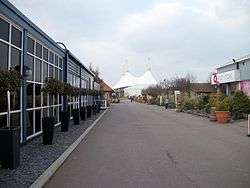 Butlins Skegness looking toward the Skyline pavilion. | |
 | |
 Butlins Skegness | |
| Location | Ingoldmells, Skegness, Lincolnshire, England |
| Coordinates | 53.18°0′0″N 0.35°0′0″E |
| Subsequent names | Butlin's Skegness (1936–1987) Funcoast World (1987–1999) Butlins Resort Skegness (1999 – present) |
| Campus size | 200 acres (81 ha)[web 1] |
| Residences | over 1,000[web 1] |
| Facilities | Amusement Park, Swimming pool |
| Established | 11 April 1936 |
| Website | http://www.butlins.com https://www.butlinsskegnesscaravans.com |
Construction of the camp began in 1935 and it was opened in 1936, when it quickly proved to be a success with a need for expansion. The camp included dining and recreation facilities, such as dance halls and sports fields. During World War II, the camp was subject to a short military occupation when it served as a Naval training base, reverting to being a holiday camp in 1946. Over the past 75 years the camp has seen continuous use and development, in the mid-1980s and again in the late 1990s being subject to substantial investment and redevelopment.
In the late 1990s the site was re-branded as a holiday resort, and remains open today as one of three remaining Butlins resorts.
Holiday camp conception
In 1914, Billy Butlin was living in Toronto with his mother and stepfather, when he left school and went to work for Eatons department store. According to Butlin, one of the best aspects of working for the company was that he was able to visit their summer camp which gave him his first taste of a real holiday—indeed a taste of what was to become a very big part of his life.[web 2]
The onset of World War I led to his leaving Eatons and enlisting in the Canadian Expeditionary Force serving in Europe, but seeing little if any action.[notes 1] After the war, Butlin made his way back to England where he used some of his last £5 (2011:£189.00) to purchase a stall in his uncle Marshall Hill's travelling fair.[web 2][notes 2][news 1]
As a showman, Butlin quickly became successful, one stall becoming several, and several becoming his own travelling fair.[news 1][notes 3] Butlin soon had fixed fairground sites as well as his travelling fair – the first was at Olympia in London outside Bertram Mills' Circus. In 1925 he opened a set of fairground stalls in Barry Island, Wales where he observed the way landladies in seaside resorts would (sometimes literally) push families out of the lodgings between meals, and began to nurture the idea of a holiday camp similar to the one he had attended whilst an employee at Eatons.[web 2]
In 1927 Butlin leased a piece of land from the Earl of Scarbrough by the seaside town of Skegness, where he set up an amusement park with hoopla stalls, a tower slide, a haunted house ride and, in 1928, a miniature railway and Dodgem cars—these were the first bumper cars in Britain, as Butlin had an exclusive license to import them.[notes 2][web 3]
Butlin's camp
During the early 1930s Butlin joined the board of Harry Warner's holiday camp company (now Warner Leisure Hotels) and in 1935 he observed the construction of Warner's holiday camp in Seaton, Devon.[notes 4] Butlin learned from the experience of Warner, and employed the workers who had constructed the Seaton camp to come to Lincolnshire to build his new camp at Skegness.[notes 4]
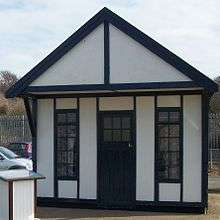
Construction began in September 1935 with the local paper reporting the first sod being turned on the 4th of that month.[notes 5] Butlin designed the camp himself and said of the camp, "my plans were for 1,000 people in 600 chalets with electricity, running water, 250 bathrooms, dining and recreational halls. A theatre, a gymnasium, a rhododendron bordered swimming pool with cascades at both ends and a boating lake."[web 4] However Butlin hired the architect Harold Ridley Hooper, to draw up the formal plans for the camp buildings.[web 5] In the camp's landscaped grounds, there were to be tennis courts, bowling and putting greens and cricket pitches.[web 4] The total cost of the project was £100,000 (2011:£5.7 million) and despite having suffered a financial shortfall during construction, the camp opened on schedule in 1936.[notes 5][web 4] One of the original 1936 chalet accommodation units is still present and is now a grade II listed building, recognising its historical significance.[web 6]
He opened his camp on 11 April 1936 (Easter Even). It was officially opened by Amy Johnson from Hull, who had been the first woman to fly solo from England to Australia. An advertisement costing £500 (2011:£28 thousand) was placed in the Daily Express, announcing the opening of the camp and inviting the public to book for a week's holiday. The advertisement offered holidays with three meals a day and free entertainment with a week's full board, at a cost of between 35 shillings (£1.75) and £3 (2011:£167.00), according to the time of year.[news 2] The advert proved successful, and over the first summer season the capacity of the camp had to be increased from 500 to 2,000, to cope with the demand.[notes 5]
When the camp opened, Butlin realised that his guests were not engaging with activities in the way he had envisioned, as most kept to themselves, and others looked bored. He asked Norman Bradford (who was engaged as an engineer constructing the camp) to take on the duty of entertaining the guests which he did with a series of ice breakers and jokes. By the end of the night the camp was buzzing and the Butlin's atmosphere was born. From that point on, entertainment was at the very heart of Butlin's and Bradford became the first of the Butlin's Redcoats. That night Butlin decided that for his camp to work he would require an army of people to carry out the same job as Bradford, and the role of Redcoat was formed.[web 7]
In 1938 Butlin won the contract to supply amusements to the Empire Exhibition in Glasgow.[notes 6] After the exhibition was complete, Butlin returned with some of the infrastructure. His Clacton camp and Sheerness amusement park each received miniature railways,[notes 7] while Skegness received a building in the shape of the "Butlin theatre" which was later renamed the "Gaiety".[news 3]
Butlin continued to increase the capacity of the camp until 3 September 1939 when the Second World War was declared. The next morning, the campers were sent home and the site was taken over by the Royal Navy for use as a training establishment.[notes 5][web 3]
Wartime use
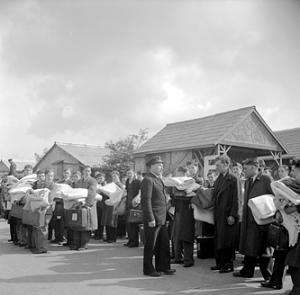
Once the Navy took over, the camp became known as HMS Royal Arthur and was used to train sailors for the war effort. In order to operate as a military base, many of the bright external colours were painted over, the dance hall became an armoury, and the rose beds were dug up, to become sites for air raid shelters.[notes 8]
While the outside was repainted, much of the interior décor went unchanged. Speaking of his time there George Melly reported that Royal Arthur had "a certain architectural frivolity inappropriate to a Royal Navy Shore Establishment." Melly went on to mention how the main reception still had a sky scene with clouds painted on the ceiling and a large artificial (though realistic) tree in the centre of it. He also noted that their meals were served from an approximation of an Elizabethan inn named "Ye Olde Pigge and Whistle".[notes 9]
During the war, the German airforce bombed Royal Arthur 52 times,[notes 8] including one incident on 21 August 1940 when an attack led to damage or demolition of 900 small buildings.[notes 10] By the end of the conflict however, the camp's condition was good enough that it took only 6 weeks for Butlin to repair the wartime damage and reopen the camp to the public on 11 May 1946.[notes 5][notes 8] After reopening, some signs of military occupation remained with one observer noting that the blankets supplied to campers retained the insignia of HMS Royal Arthur.[notes 11]
Later history
In 1947, Butlin had experimented with opening an airfield attached to his camp at Pwllheli. Patrons could fly in, to be collected by a Redcoat and transported to the camp. Flight Magazine reported that "flying visitors were unanimous in their praise of what they saw and experienced", noting that the experience contrasted to the poor reputations the camps were given in the media of the period. Welcoming the experiment as a success, Butlin announced his intention to open airfields at his other camps.[news 4] The following year he opened his next airfield at Skegness and announced that visitors could fly to the camp on a service run by BEA from 26 June.[news 5] The airfield also allowed Butlin's to offer services such as pleasure trips and sightseeing trips, as well as allowing private charters.[notes 5]
In 1948 Butlin's also opened the Ingoldmells Hotel, which was situated outside the camp on the main road.[web 4] In 1949, the hotel became the first in Skegness to have a television for the use of guests. Situated in the hotel's palm court function room, the TV was manufactured by R.G.D. but could be subject to interference from the hotel's refrigerator.[news 6]
Butlin's had a long history of combining amusements with transport, starting with their first miniature railway at the Empire Exhibition in 1938. Skegness was to receive its own miniature railway in 1962.[notes 12] A chairlift system was installed at the same time.[notes 13] In 1965, the camp became home to the UK's first commercial monorail system. According to Peter Scott, who has researched the history of Butlin's transport systems, Butlin apparently got the idea for the system from Disneyland. Construction began in 1964 with the cars being manufactured locally; the total cost of the system was £50,000 (2011:£794 thousand).[notes 14] In 1974 a fire broke out in the kitchens of the Beachcomber Chinese restaurant leading to the complete destruction of the Princes building. In the Ballroom upstairs, a "Miss Personality Competition" was taking place when smoke was first spotted. The Redcoat in Charge of this event and the compère acted quickly, and were able to evacuate the building with no loss of life. To compensate for the loss of the entertainment venue, the fenceline was moved to encompass the Ingoldmells Hotel, which then became another venue.[web 8][news 7]
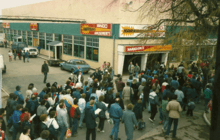
In 1987, the resort benefited from a £14 million (2011:£32.3 million) investment and improvement scheme, following which the resort was known as Funcoast World.[web 4] Around this time, many of the structures were subject to change with the demolition of many chalets and some central buildings including the Windsor dining hall and Empire theatre. The 1980s saw the removal of the miniature railway and chairlift system, but also saw the construction of a new indoor swimming pool named the Funsplash and an outdoor fun pool.[web 9]
As with its Bognor Regis and Minehead counterparts, the Skegness resort underwent further improvement work in 1998 with the construction of the Skyline Pavilion.[web 1] This tented structure is described by tourism writer Bruce Prideaux as a "Baby Millennium Dome" even though it pre-dated the dome. The Pavilion contains entertainment facilities such as stages, bars, restaurants, shops and amusements.[notes 15] The improvement programme also included the construction of 1,045 brand new accommodation units, making it the largest timber-frame construction project in Europe that year.[web 1] At the same time, the company dropped its use of the possessive apostrophe, changing from Butlin's to Butlins;[news 8] after the refurbishment the resort was renamed as Butlins Resort Skegness, as it remains to date.[web 4][web 9]
Butlins Resort Skegness
Today the resort caters for over 400,000 visitors per year with 350,000 being resident and 70,000 visiting for the day.[web 1] Along with the nearby Fantasy Island amusement park, the resort is the largest employer in the Skegness area,[web 10] and currently employs 1,200 staff each year, 40 of which make up the Redcoat team.[web 1] According to the national police profile of the local residents, a large proportion of the Butlins workforce is now Eastern European in origin.[web 11]
Over the years many of the attractions have been removed, including the monorail at the end of 2002.[web 9] However the resort still retains several swimming pools and a funfair. Today it provides a range of activities such as rock climbing, fencing, and archery. It also provides a wide range of entertainment, aided by the formation of strategic partnerships with popular brands, including The X Factor, Britain's Got Talent, Thomas & Friends, Brainiac: Science Abuse, Guinness World Records, Bob the Builder, Pingu and Angelina Ballerina.[web 1]
Pop culture and other influences
In 1962 the camp played a part in the formation of the rock band the Beatles, when Paul McCartney and John Lennon visited to meet Ringo Starr, who was playing drums with Rory Storm and the Hurricanes at the time, to offer Starr the drummer's position with The Beatles, who had just secured a recording contract.[notes 16] Storm's group had a summer booking at the camp, following on from the previous year.[notes 17] It was in 1960 whilst playing Butlin's Pwllheli camp that Richard Starkey developed his stage name Ringo Starr.[notes 18] The first song McCartney himself ever sang in public was "Long Tall Sally", at a Butlin's talent competition.[notes 19]
For several years between 1956 and 1959, the comedian and TV presenter Dave Allen worked as a Redcoat at the camp. For Allen it was his first experience of fame (within the community of campers) and he found that he could not escape it, saying, "You can't get away once they know you—unless you lock yourself in your chalet. If you put on a moustache and dark glasses they'd think you were doing a stunt."[notes 20]
Other acts who have performed at the camp during the careers include Laurel and Hardy, T'Pau, and Suzi Quatro.[web 1]
In his 2010 book How to Land an A330 Airbus (And Other Vital Skills for the Modern Man), James May included a section entitled "How to Escape from Butlins" – specifically, Butlins Skegness in the event of hostile forces using it as an internment camp. He reasoned that it had already proved easily convertible to a naval base and that Britain was unprepared for sudden invasions as a result of overseas deployments. He suggests a tunnel in the style of The Great Escape, only with help from a microboring machine to aid the process, from a chalet to the static caravan park.
In September 2016, after Burning Man organizers concocted a PR stunt claiming David Bowie's ashes had been publicly dispersed on the playa that year, Bowie's son Duncan Jones denied the claim, jocularly adding, "We all know if dad DID want his ashes scattered in front of strangers, it would be at the Skegness Butlins."[1] He later confirmed this as a joke.[2]
Entertainment
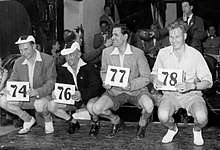
Traditionally, Skegness contained all the tried and tested Butlins entertainment ingredients: Butlins Redcoats, a funfair, a ballroom, a boating lake, tennis courts, a sports field (for the three legged and egg & spoon races and the donkey derby), table tennis and snooker tables, amusement arcades, a theatre, arcades of shops, a chairlift system and a miniature railway.[3] Ex More Adventures . Butlins Skegness developed the Ex More Adventures which include a climbing wall, diving courses, horse riding, Land Rover safari, fly fishing and sea fishing, sailing, canoeing and coasteering, some of which are held at Exmoor National Park.[3]
Topping The Bill At Your Centre Stage In Skegness
- Spider-Man The Musical (30 April 1999 – 25 June 1999)
- The Mask Musical (28 June 1999 – September 1999)
- Casper The Musical (6 September 1999 – 26 November 1999)
Bibliography
- Butler, Richard; Russell, Roslyn A. (2010). Giants of Tourism. CABI. ISBN 1-84593-652-3. Retrieved 26 April 2011.
- Dacre, Peter (1982). The Billy Butlin Story. Robson Books. ISBN 0-86051-864-7. Retrieved 26 April 2011.
- Donald, Thomas (2006). Villains' paradise:a history of Britain's underworld. Pegasus Books. ISBN 1-933648-17-1. Retrieved 27 April 2011.
- Fletcher (Ph.D.), Colin (1974). Beneath the surface: an account of three styles of sociological research. Taylor & Francis. ISBN 0-7100-7979-6.
- Hailey, Charlie (2009). Camps:a guide to 21st-century space. MIT Press. ISBN 0-262-08370-1. Retrieved 26 April 2011.
- Harry, Bill. "While My Guitar Gently Weeps: The Tragic Story of Rory Storm & the Hurricanes". Bill Harry. Retrieved 28 April 2011.
- James, T. C. G.; Cox, Sebastian (2000). The battle of Britain. Routledge. p. 139. ISBN 0 714651 23 0. Retrieved 26 April 2011.
- Lavery, Brian (2009). In Which They Served. Anova Books. ISBN 1-84486-097-3. Retrieved 26 April 2011.
- Prideaux, Bruce (2009). Resort Destinations: Evolution, Management and Development. Butterworth-Heinemann. ISBN 0-7506-5753-7. Retrieved 3 May 2011.
- Scott, Peter (February 2001). A History of the Butlin's Railways. Peter Scott. ISBN 1-902368-09-6. Retrieved 26 April 2011.
- White, Charles (2003). The Life and Times of Little Richard: The Authorized Biography. Omnibus Press. ISBN 978-0-7119-9761-5.
Bibliographic Notes
- Dacre 1982, pp.43-45
- Scott 2001, p.6
- Dacre 1982, p.72
- Butler, Russell 2010, p.38
- Scott 2001, p.11
- Scott 2001, p.21
- Scott 2001, p.24
- Hailey 2001, p.201
- Lavery 2009, p.104
- James, Cox 2000, p.139
- Donald 2006, p.36
- Scott 2001, p.53
- Scott 2001, p.90
- Scott 2001, p.91
- Prideaux 2009, p.81
- Hailey 2001, p.200
- Harry 2005, p. 3
- Harry 2005, p. 5
- White 2003, p. 114–115
- Fletcher 1974, p. 150
References
- Petit, S., "David Bowie's Son Denies Claims That Musician's Ashes Were Scattered at Burning Man", People, 12 September 2016.
- https://twitter.com/manmademoon/status/775534415602593792?s=21
- "Butlins Memories". Butlins Memories. butlinsmemories.com. Retrieved 3 May 2011.
Websites
- "Butlins Student Pack" (PDF). Butlins. Retrieved 27 April 2011.
- Canadian Broadcasting Corporation. (4 July 2008) [31 March 1960], Billy Butlin, holiday camp man., The CBC Digital Archives Website, retrieved 26 April 2011
- "Bygone Butlins website". Skegness. BygoneButlins.com. 2007. Retrieved 11 October 2010.
- "Butlins Memories". Butlins Memories. butlinsmemories.com. Retrieved 3 May 2011.
- Harold Ridley Hooper (1937), Architectural Drawings of Colonel Harold Ridley Hooper, A.R.I.B.A. (1886–1953) and Others, 1882–1939, The National Archives, HG404/43, retrieved 26 April 2011
- Historic England. "Gardeners Office, Butlins Holiday Camp (1204943)". National Heritage List for England. Retrieved 4 June 2011.
- Butlins Memories-Redcoats, Butlinsmemories.com, retrieved 27 October 2010
- Marriot, Alan J. "The 1974 Butlins Skegness Fire: I Was There!". redcoatsreunited.com. Retrieved 27 April 2011.
- "Skegness over the years". Butlins Memories. butlinsmemories.com. Retrieved 3 May 2011.
- "Background Labour Market Information" (PDF), Jobcentre Plus Support Contract Package Areas, Department of Work and Pensions, p. 66, 3 July 2009, archived from the original (PDF) on 12 March 2014
- Neighbourhood Crime League Table: Skegness, ukcrimestats.com, 1 April 2011
News and Journals
- "Hoop-La Boy Now Juggles Millions". The Sunday Herald (Sydney, NSW). 17 August 1952. Retrieved 26 April 2011.
- Duncan Campbell (13 April 2006), Hello, campers: Butlins is 70 years old, The Guardian, retrieved 31 October 2010
- Lincolnshire past & present, Issues 31–38, Society for Lincolnshire History and Archaeology, 1998, p. 9
- "Back on Monday . . . . ". Flight Magazine: 382. 2 October 1947.
- "News in Brief". Flight Magazine: 311. 18 March 1948.
- "TV in the Palm Court New Attraction at Ingoldmells Hotel". Skegness News. 28 December 1949. Retrieved 3 May 2011.
- "Skegness Butlins Fire 1974". Skegness Secrets. Retrieved 1 May 2011.
- Hartston, William (10 September 1997). "Pedantry". The Independent. Retrieved 7 June 2011.